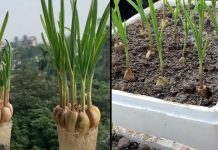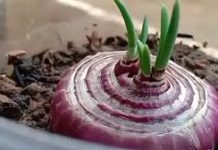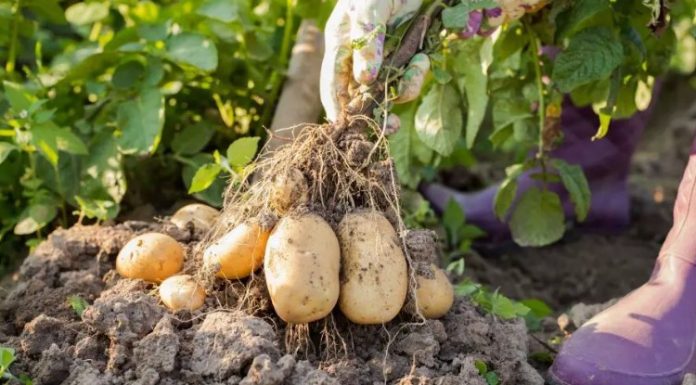Straw, a humble byproduct of grain production, is emerging as a secret weapon for savvy gardeners. Recent studies have shown that using straw mulch can reduce water consumption and increase crop yields in some cases.1 Beyond these, straw offers a myriad of benefits for both novice and experienced gardeners.
What makes straw such an effective gardening ally? And how can you harness its power in your own green space?
Here are 16 ingenious ways to use straw in your garden.

1. Mulching Magic
Straw mulch is a gardener’s best friend when it comes to weed control and moisture retention. By spreading a 2-3 inch layer of straw around your plants, you create a natural barrier that suppresses weed growth and keeps the soil moist. This simple technique can reduce your watering needs, saving both time and resources.
Not only does straw mulch help conserve water, but it also regulates soil temperature. In hot summer months, it keeps the soil cool, preventing heat stress on plant roots.
During colder periods, it acts as an insulator, protecting plants from frost damage. This temperature regulation can extend your growing season and improve overall plant health.
2. Seed Germination Booster
When starting a new lawn or overseeding bare patches, straw can be a game-changer for seed germination. A light layer of straw over newly sown grass seed helps retain moisture, prevent erosion, and protect seeds from hungry birds. This method can increase germination.

To use straw for seed germination, spread it thinly enough that about 50% of the soil is still visible. This allows sunlight to reach the seeds while providing the benefits of moisture retention and protection.
As the grass grows, the straw will naturally decompose, adding organic matter to the soil and further nourishing your new lawn.
3. Potato Growing Medium
Growing potatoes in straw is a clever technique that can yield impressive results. Start by placing seed potatoes on the soil surface and covering them with a thick layer of straw. As the plants grow, continue adding straw to keep the developing tubers covered. This method can increase potato yields compared to traditional in-ground planting.

The benefits of growing potatoes in straw are numerous. It makes harvesting a breeze – simply pull back the straw to reveal clean, unblemished potatoes. This technique also reduces the risk of soil-borne diseases and pests, as the potatoes aren’t in direct contact with the soil.
Plus, it’s an excellent option for gardeners with limited space or poor soil conditions.
4. Compost Accelerator
Adding straw to your compost pile can supercharge the decomposition process. Straw acts as a carbon-rich “brown” material, balancing out nitrogen-rich “green” materials like kitchen scraps and grass clippings. This balance can speed up composting by up to 30%, producing rich, nutrient-dense compost faster.
To use straw in your compost, aim for a ratio of about 3 parts brown (including straw) to 1 part green materials. Layering straw between other compost ingredients helps maintain airflow and prevents the pile from becoming too compacted or soggy.
This improved structure leads to more efficient decomposition and a higher-quality end product for your garden.
5. Winter Plant Protection
When winter’s chill threatens your garden, straw can serve as a cozy blanket for your plants. A thick layer of straw around perennials, roses, and other cold-sensitive plants can protect roots from freezing temperatures. This insulation can increase winter survival rates for many plants in colder regions.
To use straw for winter protection, wait until after the first hard frost to apply it. This ensures plants have entered dormancy. Pile straw around the base of plants, covering the root zone and lower stems.
For extra protection, you can create a straw “cage” around more delicate plants. Remember to remove the straw gradually in spring to allow plants to acclimate to warmer temperatures.
6. Erosion Control
Straw is an excellent tool for preventing soil erosion on slopes or in areas prone to water runoff. By spreading a layer of straw over bare soil, you can reduce erosion. This is particularly useful after construction projects or in newly landscaped areas.
To use straw for erosion control, spread it evenly over the area, aiming for about 70% ground coverage. You can secure the straw in place using erosion control netting or by lightly working it into the soil surface.
As the straw decomposes, it will help establish vegetation, further stabilizing the soil and preventing long-term erosion issues.
7. Strawberry Bed Booster
Straw is the perfect companion for strawberry plants, hence their name. A layer of straw around strawberry plants keeps the fruits clean, dry, and off the soil, reducing the risk of rot and fungal diseases. This simple technique can increase the marketable yield of strawberries.

Apply a 2-3 inch layer of straw around strawberry plants just as they start to flower. This not only protects the developing fruits but also helps suppress weeds and retain soil moisture.
As an added bonus, the straw provides a clean, dry surface for pickers to kneel on during harvest time, making the task more comfortable and efficient.
8. Natural Weed Barrier
Using straw as a weed barrier is an eco-friendly alternative to plastic landscaping fabrics. A thick layer of straw (4-6 inches) can effectively suppress weed growth while allowing water and air to penetrate the soil. This method can reduce weed growth.
To create a straw weed barrier, first remove existing weeds and prepare the soil. Lay down a thick layer of straw, ensuring complete coverage of the area. For added effectiveness, you can place a layer of cardboard or newspaper underneath the straw.
As the straw breaks down, it enriches the soil, unlike synthetic weed barriers that can degrade and leave residues in the garden.
9. Soil Amendment
Incorporating straw into your garden soil can improve its structure and fertility over time. Straw adds organic matter, which enhances soil’s water-holding capacity and promotes beneficial microbial activity.

To use straw as a soil amendment, work it into the top 6-8 inches of soil in the fall. This gives it time to break down over winter. You can also add straw to your garden beds in layers throughout the growing season, allowing it to decompose slowly.
As it breaks down, straw releases nutrients and improves soil tilth, creating an ideal environment for plant roots.
10. Greenhouse Insulation
Straw bales can serve as excellent insulation for greenhouses or cold frames, helping to maintain consistent temperatures. By stacking straw bales around the exterior of a greenhouse, you can reduce heat loss, extending your growing season and saving on heating costs.
To use straw for greenhouse insulation, place bales snugly against the exterior walls, stacking them as high as possible. Cover the bales with plastic sheeting to protect them from moisture. This insulation is particularly effective in colder climates or for overwintering tender plants.
Remember to remove or replace the straw annually to prevent mold or pest issues.
11. Natural Pathway Material
Create charming, eco-friendly garden paths using straw. A thick layer of straw makes for a soft, natural walkway that suppresses weeds and provides a dry surface in wet conditions. This method can reduce pathway maintenance compared to bare soil or gravel paths.
To create a straw pathway, first define the edges of your path with edging material. Lay down a thick layer of cardboard or several layers of newspaper to suppress weeds, then cover with 4-6 inches of straw.
Replenish the straw as needed throughout the season. As it breaks down, it will enrich the soil beneath, making it easy to convert back to planting areas in the future if desired.
12. Chicken Coop Bedding
For gardeners who also keep chickens, straw makes excellent coop bedding. It’s absorbent, insulating, and helps control odors. Using straw in chicken coops can reduce ammonia levels compared to other bedding materials, creating a healthier environment for your birds.
To use straw as chicken coop bedding, spread a 4-6 inch layer on the coop floor and in nesting boxes. Replace or add fresh straw as needed to maintain cleanliness. The used straw, enriched with chicken manure, can then be composted to create nutrient-rich fertilizer for your garden, completing a sustainable cycle.
13. Mushroom Cultivation
Straw is an ideal substrate for growing certain types of mushrooms, particularly oyster mushrooms. This method can yield up to 1 pound of mushrooms per 5 pounds of straw, making it an efficient and rewarding way to produce your own gourmet fungi.
To grow mushrooms on straw, you’ll need to pasteurize the straw first by soaking it in hot water. Once cooled, mix the straw with mushroom spawn and pack it into bags or containers with air holes. Keep the straw moist and in a dark, humid environment.
Within a few weeks, you’ll see mushrooms fruiting from the straw, ready for harvest.
14. Natural Cooling System
In hot climates, straw can be used to create a natural cooling system for outdoor living spaces or garden sheds. A straw bale wall can reduce interior temperatures by up to 20°F compared to ambient outdoor temperatures, creating a comfortable microclimate without the need for electricity.
To create a straw cooling wall, stack bales to form a wall on the sunniest side of your space. You can wet the straw periodically to enhance the cooling effect through evaporation. This technique is particularly effective in dry climates.
For added aesthetic appeal, you can plant trailing vines or succulents in the straw wall, creating a living, cooling barrier.
15. Fruit Tree Mulch

Straw makes an excellent mulch for fruit trees, helping to conserve moisture, suppress weeds, and regulate soil temperature. Studies have shown that using straw mulch around fruit trees can increase fruit yield compared to unmulched trees.
Apply a 3-4 inch layer of straw in a wide circle around the base of fruit trees, extending to the drip line of the canopy. Keep the straw a few inches away from the trunk to prevent moisture buildup and potential fungal issues.
Replenish the straw annually or as needed. As it breaks down, it will enrich the soil, providing a slow-release source of nutrients for your fruit trees.
16. Natural Dye Source
For the crafty gardener, straw can be used to create natural, eco-friendly dyes for fabrics or Easter eggs. The golden hue of straw can produce lovely pale yellow to warm tan shades, depending on the mordant used. This sustainable dyeing method reduces the need for synthetic dyes, which can be harmful to the environment.
To use straw as a natural dye, simmer chopped straw in water for about an hour, then strain. The resulting liquid can be used to dye natural fibers like cotton, wool, or silk. Experiment with different mordants (such as alum or iron) to achieve various shades. This technique not only provides a fun craft activity but also showcases another versatile use for this humble garden material.
Straw proves to be an invaluable asset in the garden, offering a wide array of applications that benefit both plants and gardeners. By incorporating these 16 innovative techniques into your gardening routine, you can enhance soil health, boost crop yields, and create a more sustainable outdoor space.










